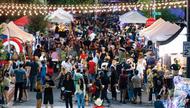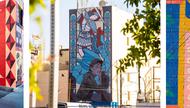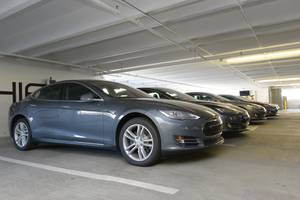"What's your favorite new development in Downtown?" J Dapper asks. "Please don't say one of mine."
It's a fair question. There are a number of developers who have literally and figuratively staked out ground in Downtown Las Vegas. I like Sam Cherry's residential hi-rises (the Newport and Soho Lofts), and I'm excited to see the micro-apartments he's currently building at Casino Center Boulevard and Colorado Avenue. Brett Wesley Sperry's smart-looking buildings on Charleston Boulevard—the former gallery building that now serves as the Iron Yard coding school, and a recently opened multistory building that houses a pastry-making academy—are the architectural equivalent of parentheses, modernizing the Arts District between them. And numerous developers are steadily remaking Main Street as the dining and retail destination Downtown has long deserved.
But I'm here in Dapper's office because I like what he's doing, and the way he's doing it. And I'm not alone. "Meeting with J is totally different," says multidisciplinary artist Robin Slonina, who's working with Dapper on an experiential entertainment concept that we'll talk about shortly. "Everyone else just sent their representatives to meet with us. J not only showed up in person, but with a few members of his staff and even his sister."
A Las Vegas native (he went to Clark High) and an aficionado of midcentury design, Dapper not only remembers what Downtown looked like before the boom, he wants to hold onto as much of that lost vibe as he possibly can. And although his Downtown holdings comprise a relatively small part of his total operation (he owns about 20 properties throughout the Valley) and he no longer lives in the area (he and his family decamped for Summerlin sometime back, largely for its schools), he really lights up when he talks about Downtown Vegas. He's a believer.
"I don't fault somebody for saying this, but I think that a lot of people look at Downtown and say, 'It's kind of rough,' or, 'It's a great neighborhood, but there's not a lot of great places to shop,'" Dapper says. "When a neighborhood is up-and-coming, there's always a point in time when things start to change. But you have to make some big statements in order to actually show that things are changing."
He started with a trio of projects on the corner of Charleston Boulevard and Maryland Parkway: the former Gambler's Book Club, the former Mahoney's Drum Shop and a 60-plus-year-old, 62,000-square-foot shopping center without so much as a street-facing sign. Dapper began what automotive people call a "sympathetic restoration" of the properties, almost immediately commissioning a Googie-style neon sign from YESCO with the shopping plaza's name prominently featured: Huntridge Center.
I live in the Huntridge neighborhood, so it probably goes without saying that I like the new sign. In the days before Google Maps, it could have proven a valuable wayfinding tool: "Turn right after Huntridge Center. If you get into the Charleston Street Taco District, you've gone too far."
But even in a post-directions world, the sign makes me feel better about my neighborhood. There's a 50/50 chance you don't know the name of the Valley neighborhood you live in, much less have a big retro-style neon sign anchoring it to the map. Dapper isn't just revitalizing old retail and industrial buildings in the city core. Yes, that's a big part of what he's doing, but more importantly—and I'm not sure Dapper himself realizes he's doing this, or maybe he's too modest to say it—he's reinforcing Downtown's sense of civic identity.
During the Fremont Street bar-building spree several years back, numerous developers called Downtown Vegas "a blank slate"—a sprawling insignificance, ready to be wiped clean and remade. Dapper not only remembers the names and places on that slate, but he's willing to put them in giant neon lights. And consdering one of Dapper's recent acquisitions is the Huntridge Theater—the 75-year-old historic property that helped shape the identity of an entire generation of Las Vegans—it might be time to begin appreciating J Dapper's "big statements."
Building out from the century
"It has to start off with residential [density]," Dapper says. "When I bought the Huntridge Center, I knew that ingredient existed behind it. That was probably the biggest reason that I took the chance ... and at that point in time, it really was a chance. People asked me, 'Are you sure you want to buy this old, crappy place?'"
Huntridge Center wasn't without its charms when he purchased the property in 2016. Its tenant mix was a bit idiosyncratic—a Savers, a neighborhood pharmacy, a Circle K gas station, a rockabilly-fueled barbershop and a classic Downtown dive bar called Huntridge Tavern—but it also had a lot of dead and underused space. A former supermarket sat vacant; an abandoned Farm Basket stood on the property's east side, drawing squatters. By day, the parking lot offered little in the way of shade, and at night it was dimly illuminated by a handful of floodlights.
Some of the fixes were quick and obvious. The former Farm Basket was torn down, and security began patrolling the property around the clock. The pharmacy moved into a smaller space so that a much-needed new tenant, Wing Stop, could begin drawing new customers to the plaza. Around the time the sign went up, Dapper began reconfiguring the parking lot to add landscaping and improved lighting. Shortly after that, the Savers was remodeled—new front windows, new cash-wrap stations, polished concrete floors—and the Circle K was completely overhauled, with Atomic Age chevron-shaped neon awnings over its gas pumps and a snazzy new sign.
"The Circle K used to be a place where nobody felt safe going late at night, and maybe not even in the daytime. That's no longer the case," Dapper says.
Other changes were more subtle. The Huntridge Tavern's old restrooms were demolished and new, larger ones built. (But that's the only change Dapper made to the venerable bar; its smoky, marinated vibe remains intact.) Floor-to-ceiling windows were added to the center's eastern face, which was previously solid, forbidding plaster. And beginning in late 2018, the walls surrounding the center—the ones that border the Huntridge neighborhood itself—have been steadily covered with murals by JW Caldwell, Sierra Slentz, Lance Smith and other local artists. What was formerly a no man's land of broken glass is now an increasingly popular destination for Instagrammers—that is, when they're not out front, taking pictures with the gas station.
Work on Huntridge Center continues even now. The stand-alone building that has replaced the Farm Basket—a soon-to-open home for Capriotti's Sandwich Shop and Roberto's Taco Shop, with an elegant swooping roof and towering glass walls—is designed by the local architectural firm Bunnyfish, whose offices are just up the street from Huntridge Center. A "diner/delicatessen concept" is currently being planned out by Golden Tiki/Evel Pie owner Brandon Powers, Capriotti's CEO Ashley Morris and Great Greek Mediterranean Grill co-founders Trent Jones and Nick A. Della Penna. And the supermarket space is currently earmarked for that aforementioned entertainment concept. (We're getting there; hold tight.)
Nearby, the former Gambler's Book Club—originally the Valley's first Safeway—has been transformed from an anonymous barrel-roofed box into a thoroughly modern office for upscale interior design firm Henriksen Butler. ("It almost looks like it was done by Frank Lloyd Wright; it's such a beautiful rehab," says Brad Jerbic, Las Vegas' City Attorney.) The Mahoney's Drum Shop space is on the verge of pulling a "refreshed" building permit, Dapper having resolved a number of issues related to rehabilitating old buildings. Work has begun on revamping the three-story U.S. Postal Service building at 201 Las Vegas Boulevard S. (just a block south of Fremont Street). Once completed, the 48-year-old building will offer 30,000 square feet of brand-new office space; a renewed post office branch (the existing branch, currently relegated to a portable building in the parking lot, is being "right-sized" and restored to its original 1970s look); and food and beverage operations at ground level and in a new rooftop space. When it's complete, this scrubby old office building will look like a jewel.
Dapper also recently closed on a building at 801 S. Main St., one with some sentimental meaning for him: "That was the Western Cab building for 30 years, and my wife's grandfather, Herb Tobman, started off Western Cab." (The family still owns the company, though they no longer run daily operations.) "I remember when my wife came home sad because the cab company was moving out of the building and putting it up for sale. ... And I said, 'Well, maybe we should buy it.' And she asked, 'What are you going to do with the cab company building?' 'I don't know, but I'll figure it out.'"
Dapper named the building the Herbert, after Tobman. Once refurbished, the two-story complex will feature creative office space, a second-floor patio and a giant Great Greek location. Dapper says that would have appealed to Tobman, who loved dining out. "He was a bigger-than-life character," he says. "It's really cool to be able to name the building after him."
Now, about the theater (and the park, and the time machine)
I should have known better than to ask Dapper if he'd ever seen shows at the Huntridge Theater. This is a man with a state-of-the-art turntable and a sprawling vinyl collection prominently displayed in his office. (We listened to Coltrane while we chatted.) He listed No Doubt/Sublime (May 1996) and Smashing Pumpkins (February 2000) as two of his favorites, then printed out a list for me of nearly every touring live act that ever appeared on the Huntridge stage, beginning with Pantera in 1991.
The drama surrounding the Huntridge Theater—its openings and closings, its current state, previous offers for the property that fell through—could fill its own feature piece; for the sake of brevity, I won't rehash it here. (Nor will I list the venue's virtues—that it was the first integrated movie theater in Las Vegas, for one, or that it was designed by distinguished motion picture theater architect S. Charles Lee.)
Suffice it to say that Dapper has been circling the theater for a while, angling for a favorable price. (He also wanted to make sure he wasn't shelling out money for anything that had already been paid for: "We're paying a price for a building that has a fixed roof," he says.) Now, with help from the City of Las Vegas—particularly City Attorney Jerbic—Dapper has entered an agreement to purchase the theater for $4 million.
Jerbic applauds Dapper's tenacity in pursuing a deal for a property that many people considered to be doomed. "It's been sitting vacant for so long," Jerbic says, acknowledging the property's structural and aesthetic issues. "It's got a lot of hair on it."
But Dapper is like, Long hair, don't care. And assuming the next six to eight months of "structural and environmental due diligence" go smoothly, he'll begin to renovate the property into—grab on to something!—a music and performing arts venue.
"There's a great example of the direction we'd like to go," he says. "It's called the Belly Up, and there's one in Solana Beach [California] and one in Aspen, Colorado. It's a very popular concert venue that's been around for a long time, and it's got a food and beverage component. The Belly Up embraces the local music community. You can go there regularly, let's say 20 to 25 nights a month, and see great local bands—but they also have the Rolling Stones or Snoop Dogg coming there to play [private parties]. There's a lot of pride in playing the Belly Up."
"When you look at the long list of amazing performers that have been at the Huntridge, from the Beastie Boys to the Foo Fighters, you realize the provenance in that building is just huge," Dapper continues. "I've seen a lot of developers take an old theater like the Huntridge and renovate it, but they haven't just renovated a theater. They built a multifamily or office component around the theater, which is what helps it to pencil out.
"The goal is to also have a really good food and beverage component attached to the Huntridge, open to the public seven days a week. It'll be a great place where everybody loves to go for lunch or dinner, or to have a drink. ... It's going to be a place where people can get together and socialize. And when a concert starts, that same company is going to be doing the concessions for the Huntridge Theater."
These wonderful, blue-sky plans are, of course, still taking shape; Dapper likely won't know what kind of ground plan he's dealing with until summer at the earliest. In the meantime, he's got another Huntridge-area project to develop: Time Machine, an experiential entertainment concept. Its website (timemachinelv.com) describes it as an interactive art experience with "aspects of a science exploratorium, an escape room and a playground"; Robin Slonina, a partner on the project with Sean Pasinsky and Sarah Larsen, simply calls it a "ticketed immersive attraction" with "a lobby café, gift shop and small art gallery in the front that's free and open to the public." Think along the lines of Meow Wolf, only with all local artists.
Time Machine is set to move into Huntridge Center's vacant supermarket space. And though Dapper is mildly disappointed he couldn't get a grocery store to move in (Trader Joe's nibbled but ultimately passed), he likes the energy the project is bringing to the center. "I truly believe in what they're doing," he says. "There are a lot of people that just don't care about sitting in front of a slot machine that still want to come to Vegas. That's the kind of person that we're interested in."
For her own part, Slonina was somewhat surprised by how quickly Dapper warmed to the idea. "Immediately, I thought, 'He's taking this seriously,'" she says. "I felt that he was going to be more than a landlord. He was going to be a supporter, a development partner."
In fact, Dapper and the Time Machine crew are getting on so well they're partnering on yet another project: the rehabilitation of nearby Huntridge Circle Park. Dapper has committed to redoing the children's playground portion; the Time Machine crew wants to create an interactive sculpture park in the other half of the park. Dapper says that an announcement of the project will be made as soon as they can "get everything buttoned up" with the City.
"He's a local, and he loves Las Vegas," Jerbic says. "When you meet people who have the same passion that some of us do that have lived here our whole lives, it's a great partnership."
It's altogether fitting that one of Dapper's projects is a neighborhood gathering place. When he's asked about the most rewarding parts of his job, he talks about other people: the architects, engineers and tradespeople who build out his spaces, and the families and workers who use them. To him, there's nothing more satisfying than employing people to build a better city, and then watching his neighbors live in it.
"It's pretty rewarding when you go to a shopping center or an office building that was once kind of desolate and lingering, and then you make it full of activity," Dapper says. "And you know that that little slice of the world got better because of your efforts. That really makes me happy."









